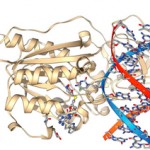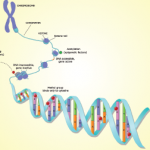 Epigenetic modifiers act on DNA by changing its chromatin and methylation status. In this way, epigenetic modifiers can define cell function. These modifiers also act to establish and maintain cell lineage via specific epigenetic status. One group of epigenetic modifiers is known as ten-eleven translocation (Tet) methylcystosine dioxygenase family members. The Tet family of genetic modifiers is able to catalyze several different DNA modifications. The nuclear Tet proteins act independently of DNA methylation and, instead, regulate chromatin architecture and gene transcription.
Epigenetic modifiers act on DNA by changing its chromatin and methylation status. In this way, epigenetic modifiers can define cell function. These modifiers also act to establish and maintain cell lineage via specific epigenetic status. One group of epigenetic modifiers is known as ten-eleven translocation (Tet) methylcystosine dioxygenase family members. The Tet family of genetic modifiers is able to catalyze several different DNA modifications. The nuclear Tet proteins act independently of DNA methylation and, instead, regulate chromatin architecture and gene transcription.
Tet proteins are implicated in the immune response and have an established role as chromatin modifiers during response to lipopolysaccharide (LPS). Although little is known about how Tet proteins are able to regulate immunity and inflammation, studies have revealed that a dysfunction of Tet2 is associated with the pathogenesis of myeloid malignancies. Qian Zhang, a crystallographer at the Chinese Academy of Medical Sciences in Beijing, China, and colleagues investigated the role of Tet2 in the inflammatory response and published the results in the Sept. 17 issue of Nature. They found that Tet2 acts at the chromatin level to reduce inflammation by preventing constant transcription activation. It represses gene-specific transcription via histone deacylation.
The researchers began their investigation with innate myeloid cells and found that Tet2 played a role in the resolution of inflammation of both dendritic cells and macrophages. Specifically, Tet2 selectively and actively repressed the transcription of interleukin-6 (IL-6). The investigators next examined Tet2-deficient mice and found the knockout mice were more susceptible to endotoxic shock and dextran-sulfate-sodium-induced colitis than were wild-type mice. The knockout mice also displayed a more severe inflammatory phenotype than wild-type mice. The inflammatory phenotype included increased production of IL-6. In general, the inflammatory markers in the knockout mice tended to be up-regulated during the late phase of the response to LPS challenge—a result that was consistent with the observations from their in vitro experiments.
When the investigators over-expressed Tet2, they found that the Il6 promoter was repressed. A closer examination revealed that the IL-6-specific transcription factor IҡBξ mediated specific targeting of Tet2 to the Il-6 promoter. The result suggests that IҡBξ can have opposite regulatory roles depending on whether it is acting during the initiating phase of inflammation or the resolution phase of inflammation. When Tet2 is acting to repress the Il-6 promoter, it recruits histone deacetylase 2 (Hdac2) and represses transcription of Il-6 via histone deacylation, acting independently of DNA methylation and hydroxymethylation.
Taken together, the results suggest that the resolution of inflammation requires a repression in inflammatory gene transcription, which, in turn, requires epigenetic modifier-mediated active chromatin regulation. When this approach fails, the organism experiences an exacerbation of the inflammatory response as demonstrated by endotoxic shock and colitis. This more detailed understanding of the molecular regulation of the cessation of cytokine production may ultimately suggest new therapeutic strategies for the resolution of inflammatory processes.
Lara C. Pullen, PhD, is a medical writer based in the Chicago area.
Reference
- Zhang Q, Zhao K, Shen Q, et al. Tet2 is required to resolve inflammation by recruiting Hdac2 to specifically repress IL-6. Nature. 2015 Sep 17;525(7569):389–393. doi: 10.1038/nature15252


